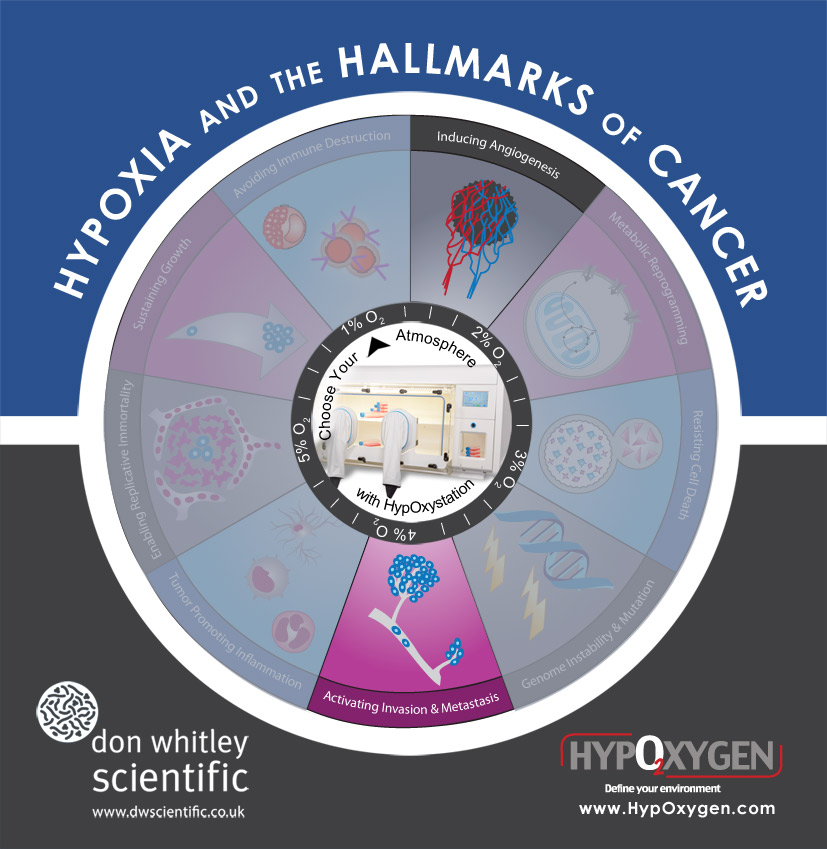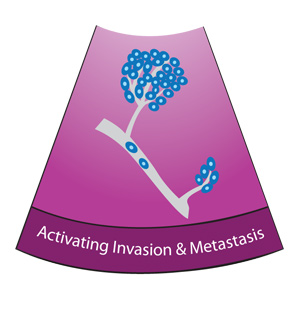Hanahan and Weinberg’s “Hallmarks of Cancer” are at the root of the multi-step progression of cancer, and they are all influenced by hypoxia in the tumor microenvironment. In this mini-review series, HypOxygen has been taking a closer look at the way HypOxystation users worldwide are delineating the effects of hypoxia on the Hallmarks of Cancer: so far, we’ve showcased Avoiding Immune Destruction and Tumor Promoting Inflammation and Genome Instability and Mutation and Enabling Replicative Immortality.
In the HypOxystation hypoxia workstation, researchers working with cells in culture can mimic the physiological conditions that produce those characteristic Hallmarks. The HypOxystation enables glove-less access to cultivate and manipulate cells under physiological conditions, in a HEPA-clean environment. Oxygen levels in the HypOxystation can be reliably and accurately adjusted to below 1%, reflecting the high metabolism, low perfusion tumor microenvironment.
In the third part of our series, we’ll be showcasing research by HypOxystation users looking at 2 more Hallmarks: “Inducing Angiogenesis” and “Activating Invasion and Metastasis”.

1. Inducing Angiogenesis
Angiogenesis and tumor-associated neo-vascularization are central to the progression of cancer, and hypoxia in the fast-growing, poorly perfused tumor setting is one of the main factors driving the formation of new vessels. Hypoxia in the tumor activates the hypoxia stress response, which is mediated at the cellular level by HIF, VEGF and many other cytokines, growth factors and guidance molecules. As a consequence, endothelial cells and pericytes proliferate and form new blood vessels, which are, however, disorderly and leaky, in turn exacerbating hypoxia in the tumor. Cancer treatment strategies striving to normalize tumor vessels for the purpose of improved drug delivery and alleviation of hypoxia in the tumor are showing great promise.
 LITERATURE:
LITERATURE:
- Herzog et al. (2016) “Cyclin-dependent kinase 5 stabilizes hypoxia-inducible factor-1α: a novel approach for inhibiting angiogenesis in hepatocellular carcinoma” Oncotarget. 2016 May 10; 7(19): 27108–27121
www.impactjournals.com/oncotarget/index.php?journal=oncotarget&page=article&op=view&path%5b%5d=8342&pubmed-linkout=1 HypOxystation user - Collet et al. (2016) “Endothelial precursor cell-based therapy to target the pathologic angiogenesis and compensate tumor hypoxia” Cancer Letters 370 (2016) 345–357
www.cancerletters.info/article/S0304-3835%2815%2900682-5/abstract HypOxystation user - Burrows et al. (2016) " Hypoxia-induced nitric oxide production and tumour perfusion is inhibited by pegylated arginine deiminase (ADI-PEG20)” Scientific Reports 6, Article number: 22950 2016
www.nature.com/articles/srep22950 HypOxystation user - Banh et al. (2016) “PTP1B controls non-mitochondrial oxygen consumption by regulating RNF213 to promote tumour survival during hypoxia” Nature Cell Biology 18, 803–813 (2016)
www.ncbi.nlm.nih.gov/pmc/articles/PMC4936519/ HypOxystation user - Oszajca et al. (2016) “Hypoxia-selective inhibition of angiogenesis development by NAMI-A analogues” Biometals DOI 10.1007/s10534-016-9974-9
www.ncbi.nlm.nih.gov/pmc/articles/PMC5116311/ HypOxystation user - McDonald et al. (2016) “Overcoming Hypoxia-Mediated Tumor Progression: Combinatorial Approaches Targeting pH Regulation, Angiogenesis and Immune Dysfunction” Frontiers in Cell and Developmental Biology 4: 27
www.ncbi.nlm.nih.gov/pmc/articles/PMC4814851/
2. Activating Invasion and Metastasis
As with the other Hallmarks of Cancer, metastasis and cancer progression are correlated with low oxygen levels in the tumor. HIF’s activate the expression of more than 1000 genes, numerous of which play a role in inducing genes involved in the EMT, through direct interactions with HRE’s at promotor sites and other mechanisms such as epigenetic alterations, like methylation/demethylation. Hypoxia promotes migration and invasion by facilitating the endothelial-mesenchymal transition, altering cell-cell contacts, and reducing adhesion to the extra-cellular matrix. Cancer cells and neighboring cells such as fibroblasts are all influenced by hypoxia, and all contribute to the restructuring of the tumor microenvironment. The effects of the Hallmarks of Cancer continually perturb and promote each other, as when hypoxia-driven metabolic reprogramming causes acidification of the extracellular microenvironment through increased production and secretion of lactate, in turn augmenting ECM remodeling and immune evasion. Similarly, formation of novel blood vessels enables extravasation and migration of cancer cells to form new tumors.
 LITERATURE:
LITERATURE:
- Yang et al. (2017) “Anticancer osmium complex inhibitors of the HIF-1α and p300 protein-protein interaction” Sci. Rep. 7, 42860 (2017)
www.ncbi.nlm.nih.gov/pmc/articles/PMC5320473/ HypOxystation user - Elkashef et al. (2016) “Polysialic acid sustains cancer cell survival and migratory capacity in a hypoxic environment” Nature Scientific Reports 2016 6:33026
www.nature.com/articles/srep33026 HypOxystation user - Madsen et al. (2015) “Hypoxia and loss of PHD2 inactivate stromal fibroblasts to decrease tumour stiffness and metastasis”
onlinelibrary.wiley.com/doi/10.15252/embr.201540107/pdf HypOxystation user - Herrmann et al. (2015)“Cellular memory of hypoxia elicits neuroblastoma metastasis and enables invasion by non-aggressive neighbouring cells” Oncogenesis (2015) 4
www.nature.com/oncsis/journal/v4/n2/full/oncsis201452a.html HypOxystation user - Pettersen et al. (2014) “Targeting tumour hypoxia to prevent cancer metastasis. From biology, biosensing and technology to drug development: the METOXIA Consortium” J Enzyme Inhib Med Chem. 2014 Oct 27:1-33.
www.tandfonline.com/doi/full/10.3109/14756366.2014.966704 HypOxystation user - Kao et al. (2016) “Hypoxia, Epithelial-Mesenchymal Transition, and TET-Mediated Epigenetic Changes” J. Clin. Med. 2016, 5, 24
www.ncbi.nlm.nih.gov/pmc/articles/PMC4773780/ - Muz et al. (2015) “The role of hypoxia in cancer progression, angiogenesis, metastasis, and resistance to therapy” Hypoxia 3, 83-92.
www.ncbi.nlm.nih.gov/pubmed/27774485